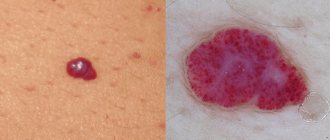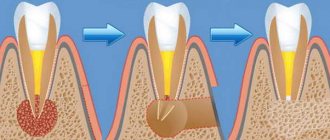Every person has several nevi on the surface of the skin. A mole on or near the lip is a fairly rare occurrence. Some consider pigment formations to be a highlight of appearance, while others consider them to be an undesirable defect.
Nevi occur due to the accumulation of melanocytes - cells responsible for the production of melanin. The bulk of moles are formed during global changes in the body. This includes puberty, pregnancy, and menopause. The process of secretion of hormones by the pituitary gland is accompanied by excessive production of pigment. Many doctors believe that the algorithm for the development of nevi is embedded in the genetic code. Members of the same family often have similar numbers and locations of pigment formations.
A mole on the lip can appear throughout life. This is due to exposure to ultraviolet radiation. Visiting a solarium and prolonged exposure to the sun lead to intense melanin production. The reasons for the formation of nevi also include:
- radiation and x-rays,
- pathologies of internal organs,
- taking hormonal drugs,
- inflammatory skin diseases,
- allergic reactions.
Causes of moles
Most moles form in childhood and adolescence. Heredity and genetic predisposition play a key role. In adulthood, the appearance of new formations is facilitated by external and endogenous factors. The most important is hyperinsolation - regular and prolonged exposure of the skin to ultraviolet radiation.
Ultraviolet light is the main catalyst for the formation of melanin pigment in skin cells, and it is melanin that determines the color of the entire skin and its elements. The appearance of a black mole may be a consequence of too frequent and long exposure to the sun. Fans of artificial tanning are at risk, since solarium lamps are a source of intense ultraviolet radiation.
Changes in hormonal balance can contribute to the appearance of new nevi. For women, a risk factor is ovarian dysfunction (imbalance of sex hormones). Changes in hormonal levels can be triggered by taking oral contraceptives and hormone replacement therapy during menopause. The formation of black moles is possible during pregnancy and lactation.
Mole in the center of the lip
A distinctive feature of the owners of the mark is stubbornness. Those with a mole on the right always try to defend their opinion in everything, listening little to what others tell them. They can defend their opinion in different ways: both verbally and using physical brute force.
Those who want to marry the owner of a birthmark on the philtrum need to be prepared to fulfill the whims of their spouse. The forces of the latter will be directed only towards self-realization. Family and household matters will remain in last place for them.
Dangerous symptoms
Only a very few black moles pose a potential threat. The risk of malignant transformation to melanoma is low, but caution should be maintained. In any case, it is advisable to show the skin lesion to a specialist. You definitely need to see a dermatologist or oncologist if you have the following symptoms:
- The black mole increases in size. Even small growth should be alarming; a rapid increase in size is an unfavorable sign.
- The surface has changed (becomes “glossy” or loose).
- The formation peels off or bleeds.
- Unpleasant sensations appear in the form of pain, burning or itching.
- The shape has changed, the edge has become striated, uneven, asymmetrical.
- The color changes: an ordinary mole becomes black, bluish or dark brown.
Any dynamics should be alarming. There is no need to panic, but you need to make an appointment with a specialist. What you definitely cannot do is try to remove the tumor yourself using traditional medicine. Injury by mechanical or chemical influence is one of the main causes of malignant degeneration.
Classification
Moles on the lip are divided into two groups.
- Pigmented. Consist of cells containing melanin. They range in color from beige to black. They are flat and convex. They usually appear near the corners of the lips: above or below. They have a high risk of malignancy - degeneration into melanoma.
- Vascular. They are called hemangiomas. They are flat spots. They are formed due to excessive growth of capillaries and disruption of the integrity of blood vessels. There are different shades of red. Localized on the surface of the lips. When pressed, the hemangioma turns pale and after some time returns to its original color. It never transforms into cancer.
Melanoma-dangerous nevi
Listed below are specific types of black moles that are melanoma-dangerous. This means that when exposed to unfavorable factors, they can degenerate into melanoma; the risk of malignant transformation is higher than in the case of ordinary nevi.
Dysplastic nevi. This type of nevi is characterized by the presence of melanocytic dysplasia, an atypical arrangement of melanocytes. Only a dermatologist can diagnose melanocyte dysplasia. The patient needs to know that a dysplastic nevus has a smooth surface. It does not rise above the skin, or only its central part rises. The shape is irregular, with uneven edges. The coloring is uneven, with black areas located in the center.
Blue nevus. Despite the name, the formation can be not only blue, but also black. Usually has the shape of a regular hemisphere and rises above the surface of the skin. The surface is smooth, the edges are even. Typical localization is the scalp, feet and hands, and gluteal region. The risk of malignancy increases after injury, including independent attempts at removal.
Nevus Ota. This type of tumor appears only on the face. Characteristic mainly for representatives of the Mongoloid race. The color is black or bluish. The differential sign is the presence of pigmentation of the sclera, iris or conjunctiva of the eye.
Borderline pigmented nevus. The neoplasm is formed in childhood. Subsequently, birthmarks increase in size throughout life, reaching one and a half to two centimeters in diameter. The differential feature is an uneven ring-shaped coloration, with a decrease in color intensity from the center to the periphery. The color is brown, darker in the central part.
Giant pigmented nevus. Refers to congenital. Increasing in size, such birthmarks reach gigantic sizes, up to 15 centimeters or more. A characteristic feature is an uneven surface with “potholes”, nodules and cracks. Hair growth from the nevus may occur.
For melanoma-dangerous moles, the risk of malignancy is higher than for ordinary skin tumors. Such nevi and birthmarks require observation by a dermatologist or oncologist. Malignant degeneration can be caused by exposure to external factors - mechanical or chemical damage, ultraviolet irradiation.
Treatment of mucosal melanoma
Today, surgery is the main treatment option and can be combined with adjuvant radiation therapy. However, the prognosis for melanomas of the mucous membranes remains unsatisfactory. Local relapses occur in half of the cases. Radiation therapy for melanomas of the head and neck mucosa somewhat stabilizes the condition, but does not improve survival in common forms of the disease.
At the same time, due to the complex topography of some tumors, it is not always possible to perform a sentinel lymph node biopsy.
For urogenital melanomas, the most accessible method is surgical. The combination of wide excision of the tumor after a course of radiation gives good results only in the initial stages of melanoma.
Immunotherapy and targeted therapy have good prospects for the treatment of common mucosal melanomas complicated by metastases to distant organs. Tumor genotyping and detection of BRAF mutations in melanoma make it possible to introduce a new generation of antitumor drugs into clinical practice.
Drugs such as Ipilimumab and Pembrolizumab are being introduced into oncology protocols, which makes it possible to expect a reduction in tumor growth rates and an increase in life expectancy for patients with mucosal melanoma.
Diagnostics
If you have a black mole on your body, it is not at all necessary to remove it, but you need to contact a specialist. The dermatologist will conduct a diagnosis, which consists of examining the neoplasm and studying it using optical or digital dermatoscopy (under magnification).
During the examination, the doctor evaluates the size of the tumor, its density, structure, consistency, surface character, symmetry, edge, color and other signs. As a rule, examination and dermatoscopy are sufficient to make a diagnosis. Biopsy and histological examination are carried out only before removal. In other situations, dermatologists prefer not to injure black moles unnecessarily.
What moles on the face “say”
Since the time of the Inquisition, moles, age spots or birthmarks on a person’s body or face have been interpreted as symbolic. In this case (during the period of the Inquisition) they were regarded as marks of the devil or mystical signs, especially regarding formations on the face or hands. It was believed that Satan himself thus marks those whom he has chosen for his service. Most often, women suffered from this: if there was a mole on her body, and even more so, its location was on her face, then the woman most likely ended up in an Inquisition trial, where her guilt was determined, and the trial was followed by burning at the stake.
But already in the 18th century, the idea of moles and people with moles changed dramatically. This was due to the legend that existed at that time that the face of the goddess of love and beauty Venus was decorated with a mole. Therefore, a mole, and even on the face, was considered a sign of the patronage of Venus, and women of different classes and ages introduced the fashion for so-called flies, usually moles drawn above the lip (as it was believed - for good luck).
Recommended articles on the topic:
- Painless lip modeling: techniques and recommendations
- Beauty injections: types, preparations, reviews
- Eyelash restoration at home and in a beauty salon
Today, when many signs and prevailing opinions are a thing of the past, attitudes towards moles have been revised again. In the modern world, many people are indifferent to them, although various fortune tellers also endow them with sacred meaning and try to determine fate by the moles a person has. There are many articles that describe the meaning of moles based on their location on the body. However, there is no unambiguous assessment of this theory: there are those who unconditionally believe in it, and those to whom this whole version seems unrealistic, illogical and absurd.
We will still try to correlate a person’s moles with his possible fate and future.
There are different approaches to examining moles on the human body and face. One of the most popular is to look at the shape of the mole and its size. It is believed that if a mole is round in shape, it will bring goodness to its owner. A more elongated and oblong mole is a sign of good luck, but a sharp mole symbolizes the uncertainty of life.
If a mole is on the face, namely on the left eyebrow, this may indicate a late marriage, while a mole on the right eyebrow, on the contrary, means an early marriage.
If a mole is located in the area of the lips or directly on the lip, then it is believed that its owner will be endowed with great love, real feelings and generally marked with the sign of Venus, but at the same time, the character of such a person may be distinguished by hypocrisy, some superficiality or frivolity, and also fear loneliness. The same mole can have another interpretation - it can distinguish a person who is cheerful, kind and open to the world.
As soon as you have a mole on your right cheek, stormy love experiences will soon begin in your life, and if on your left, then you will probably soon encounter troubles and troubles.
A mole on the nose symbolizes success in everything and is considered a sign of incredible luck.
A mole located in the corner of the eye is found in a person with a calm and measured character.
We can conclude that the face is the place on which a mole is always a symbol or sign of some qualities or signs. And if you are planning to remove a mole, then you should first look at what it symbolizes. Perhaps this is a mole of total luck, wealth and prosperity, or the best health, and it is no coincidence that it appeared on your body.
Read material on the topic: Laser facial skin rejuvenation: useful tips and recommendations
Treatment: removal or observation?
Benign neoplasms of the skin do not require removal, but surgery can be performed for aesthetic reasons, as well as in situations where the nevus is located in an open area of the body, is exposed to ultraviolet radiation, or is injured by parts of clothing or jewelry.
Removal of benign black moles that are not melanoma-dangerous is carried out in the following ways:
- Surgical removal;
- cryodestruction;
- electrocoagulation;
- radio wave removal;
- laser removal.
Melanoma-dangerous nevi can only be removed surgically. The operation is performed in the presence of an oncologist and involves healthy skin. The removed tissues are necessarily sent for histological examination. Melanoma-dangerous nevi can also be removed in aesthetic medicine clinics if the medical institution has a dermatologist oncologist on staff. The operation is performed in a classical way; cryodestruction and other modern technologies are not used.
If malignant degeneration of the neoplasm is diagnosed, complex antitumor therapy is indicated, which includes surgical removal with wide coverage of adjacent tissues, radiation and chemotherapy.
Mole on the right - the most current meanings
A dark spot on this side is a sign of a confident and established personality. Ladies who have moles have a tough character, similar to a man’s. It is difficult for them to build relationships with the opposite sex, especially with a male leader. However, at work it’s easy for such girls: they cope with their responsibilities perfectly and enjoy authority among their subordinates.
For men, a mole on the right is a good sign. Individuals are distinguished by determination and strength of character. This is the complete opposite of those who have a mole to the left of the lip: they can take responsibility for loved ones and always keep promises. A young man with a birthmark on the right side is a calm and family-oriented person.
After the procedure
After removing a nevus, it is extremely important to protect the skin from ultraviolet radiation. You can’t sunbathe in a solarium; you should be in the sun as little as possible. It is recommended to refrain from thermal procedures. It is impossible to remove crusts at the site of the surgical wound; the skin should be provided with maximum rest. After removing a mole on the face, it is not advisable to use decorative cosmetics.
You can learn more about the diagnosis of skin tumors and methods of their treatment at a consultation with a dermatologist at the Galaktika clinic (Moscow).
Which methods of removing moles on the face are good and which are not?
Today there are many different methods for removing moles:
- Surgical;
- Cryodestruction (removal of moles with nitrogen);
- Electrocoagulation;
- Application of CO2 laser.
It is necessary to choose the right treatment method to achieve maximum effect.
Removing moles on the face with laser
Taking into account the fact that there are a huge number of methods for combating moles, one of the most productive is laser removal of a mole on the face, since it is this method that allows you to regulate the depth of laser exposure and ensure maximum precision with minimal damage to surrounding tissues. Moreover, we are talking about removing nevi specifically on the face or other open surfaces of the body.
Laser removal requires local anesthesia. The action of a high-precision laser beam is aimed at gradually removing the surface of the mole layer by layer.
Laser surgery to remove a mole (especially on the face) has many advantages over other types of removal:
- One hundred percent guarantee of mole removal after the 1st procedure;
- No bleeding;
- Rapid wound healing – a maximum of a week;
- Almost complete absence of subsequent complications, such as scars after removal of moles on the face, scars, pigmentation.
Another advantage of laser mole removal is its painlessness and very short operation time (only a few minutes).
After removing a mole, however, you must follow a few fairly simple rules:
- Try to avoid the influence of high and low temperatures on the skin, contact with direct sunlight.
- To dry the skin of the treated surface areas, you need to blot them rather than wipe them;
- For 2 weeks, forget about saunas/solariums/swimming pools/sunbathing. If you need to go outside, you need to apply sunscreen with a factor of at least 35 SPF (if we are talking about the face, then this is a mandatory condition);
- Use only alcohol-free products to care for the face and treated skin area in the next three days after surgery.
After removing a mole with a laser, a small dried crust will appear that does not need to be peeled off - it will fall off on its own in the next seven days. When the healing process comes to an end, there will be no scars or any other marks left in this place, as well as other consequences. Laser mole removal is one of the safest procedures if performed by a competent specialist.
Surgical removal of a mole on the face
This method is most often used to remove large and deep tumors. Anesthesia is required for its implementation. After the operation, sutures are placed at the removal site, which must be removed after five days. This method leaves behind scars, which over time take the form of barely noticeable white scars, so it is practically not used to remove moles on the face.
For this operation, the risk of bleeding and infection is quite high.
Cryodestruction
Cryodestruction is the process of freezing a nevus with liquid nitrogen (temperatures up to -180 degrees).
This method is also not used to remove moles on the face, because it is quite specific: the tissue that has died during the procedure is not eliminated, but remains in place, forming a kind of protective film. Healthy skin begins to form underneath, but this is a rather lengthy process - healing after removal can take twice as long as when using a laser.
However, this method also has its immediate advantages:
- The mole disappears absolutely without a trace, and 100% there will be no scars on the face;
- The recovery process is painless.
- Antiseptic effect.
The disadvantages of this method are that it is not always possible to remove a mole at once (sometimes it is necessary to perform another procedure). Also, the area of nitrogen exposure cannot always be precisely limited, and this can lead to damage to surrounding healthy tissue. Plus, there is a possibility of getting a burn, which can slow down the already slow process of facial skin restoration.
Electrocoagulation for mole removal
Removal of moles by electrocoagulation can be performed on any area of the skin, including the face. This is the removal of moles using an electric current pulse that burns the mole from the skin.
The advantages of this method are that:
- The mole is removed in one session;
- The procedure is suitable for all types of moles and for all areas of the skin;
- No blood;
- High speed.
Disadvantages: after removing a mole using this method, a scar may remain (although it is usually barely noticeable, but on the face this is usually critical).
Read material on the topic: Plasmolifting of the face - a breakthrough in domestic cosmetology
Radio wave destruction
The most modern and advanced method of removing skin tumors is radio wave destruction.
Contrary to fashionable consumer demand for laser removal, it is the radio knife that gives the optimal result. This unique non-contact method of skin incision and coagulation using the SURGITRON radio wave surgical generator has proven itself excellently all over the world.
The essence of the method is that the energy of high frequency radio waves (3.8-4.0 MHz) is concentrated at the tip of the thinnest working electrode. Its powerful flow, directed at the object being removed, causes a surge of intracellular molecular energy, which increases the temperature and actually evaporates the cells. In this case, there is no direct contact of the electrode with the skin. The doctor, having set the parameters necessary for a specific manipulation (wave shape and power), completely controls the depth and area of influence and removes the pathological skin tumor as carefully as possible, literally with pinpoint precision.
What is extremely important: this method
removal
allows you to remove the skin tumor entirely
and
the resulting biopsy specimen for histological examination
. Histological examination must be carried out both according to the requirements of the Ministry of Health, and in order to identify possible malignant transformation of the tumor and prevent the development of skin cancer. Unlike radioknife, when removing with any laser, liquid nitrogen and chemical acid, it is impossible to obtain a biopsy specimen and perform a histological examination.
Contraindications to the tumor removal procedure are:
- Pulmonary heart failure in the stage of decompensation;
- Acute infectious diseases;
- Feverish state;
- Chronic hepatitis in the stage of decompensation;
- Diabetes mellitus in the stage of decompensation;
- The patient has a pacemaker and epilepsy.
Features and advantages of laser technology
Many people prefer to remove moles using a laser. This technique has a number of advantages, including:
- high performance. It is possible to completely get rid of angioma in one procedure;
- comfort. Laser removal is carried out using modern anesthetic substances, so the patient does not experience any discomfort;
- availability. The prices for the technique are low;
- short duration. It takes no more than 20 minutes. The exact time depends on the size and number of moles;
- lack of long-term rehabilitation;
- safety (no bleeding or risk of infection).
Contraindications to the technique are minimal. It cannot be performed in the presence of infectious diseases, diseases of the cardiovascular system, lesions of the central nervous system, which are characterized by increased excitability. The doctor will tell you more about the possibility of using this technology after the examination.
Medical correction of red moles
The doctor, after conducting an initial examination and the necessary diagnostic measures, will make a conclusion regarding the likelihood of malignancy of the red mole. Based on this diagnosis, a strategy for further therapeutic actions is developed. If a red mole does not pose an oncological threat and is located in a closed area of the body, its removal is not necessary.
In cases where the red nevus causes aesthetic or physiological discomfort to the patient, it can be removed using modern hardware techniques, the priority among which is laser destruction. This method of removing red moles guarantees painlessness and safety for the patient, and also has a low level of trauma.
Medical offers its patients the latest expert-class medical equipment that meets the most stringent European standards. Effective therapy, high-quality medical service and affordable prices are the main principles of our clinic.
Find out the cost of the procedure “Removal of tumors”
Prevention of angiomas
After establishing the true cause of the appearance of red moles, it is important to avoid provoking factors. As a preventative measure, experts recommend:
- drink at least 1.5 liters of water per day;
- eat more fresh fruits and vegetables rich in fiber;
- add olive oil to your diet;
- try to spend less time under the scorching sun;
- sunbathe only in the morning or evening (using sunscreen);
- stick to a balanced diet.
Mole under lip
This sign has good meaning for both men and women. In the first case, it testifies to the individual’s ability to get out of any, even the most difficult situations. Men with a mole under their lip are able to make the right decisions in a short time and adapt to changing conditions. Men with this mark are distinguished by an almost complete absence of bad habits and a strong-willed character.
Women with a mole on the lower part of the lip are reasonable and sedate. They listen to their reason and do not obey momentary desires and emotions. In life, such ladies value justice and independence.











